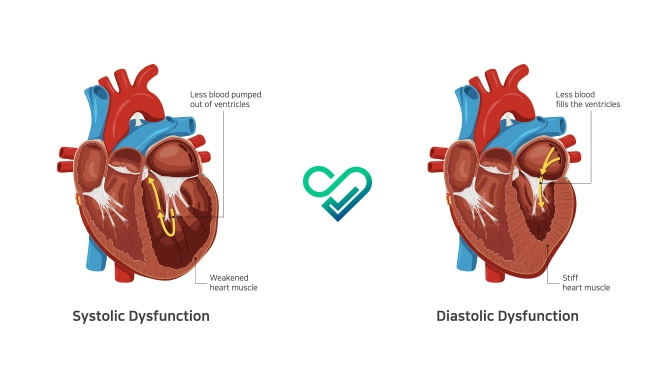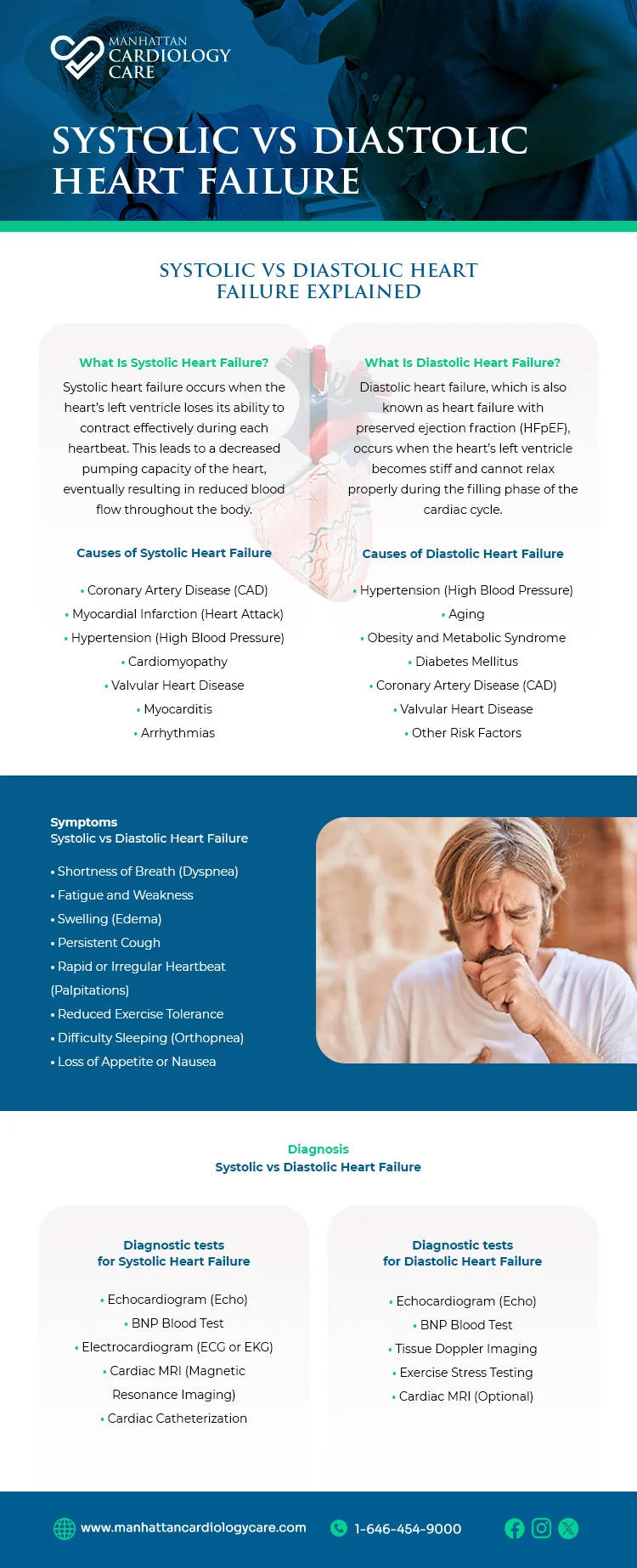Do you know how the heart works, or what happens when it doesn’t function as it should? – Understanding heart failure is an important part of maintaining cardiovascular health.
In today’s blog, we will explain the two common types of heart failures: Systolic and Diastolic heart failures. Exploring their causes and symptoms, along with the diagnosis and treatment options.
Let’s dive right into it!
Table of contents
What Is Systolic Heart Failure?
Systolic heart failure occurs when the heart’s left ventricle loses its ability to contract effectively during each heartbeat. This leads to a decreased pumping capacity of the heart, eventually resulting in reduced blood flow throughout the body.
Causes of Systolic Heart Failure
There are several factors that can contribute to the development of chronic systolic heart failure, including:
- Coronary Artery Disease (CAD)
- Myocardial Infarction (Heart Attack)
- Hypertension (High Blood Pressure)
- Cardiomyopathy
- Valvular Heart Disease
- Myocarditis
- Arrhythmias
What Is Diastolic Heart Failure?
Diastolic heart failure, which is also known as heart failure with preserved ejection fraction (HFpEF), occurs when the heart’s left ventricle becomes stiff and cannot relax properly during the filling phase of the cardiac cycle.
Causes of Diastolic Heart Failure
Identifying and understanding the underlying causes of diastolic heart failure is essential for effective management and prevention of this condition.
Causes of diastolic heart failure may include:
- Hypertension (High Blood Pressure)
- Aging
- Obesity and Metabolic Syndrome
- Diabetes Mellitus
- Coronary Artery Disease (CAD)
- Valvular Heart Disease
- Other Risk Factors
Difference Between Systolic and Diastolic Heart Failure
While both the types of heart failures share common symptoms, their underlying mechanisms and treatment options are significantly different. Chronic systolic heart failure primarily involves heart contraction being impaired, whereas diastolic heart failure is characterized by the heart relaxation being impaired.
Symptoms: Systolic vs Diastolic Heart Failure
Systolic and Diastolic heart failure share the same symptoms, which include:
- Shortness of Breath (Dyspnea): Difficulty breathing, especially during exertion or when lying flat, due to fluid buildup in the lungs.
- Fatigue and Weakness: Persistent tiredness and lack of energy, often present even with minimal physical activity, caused by reduced blood flow to tissues.
- Swelling (Edema): Accumulation of fluid in the legs, ankles, feet, or abdomen, resulting from the heart’s inability to effectively pump blood.
- Persistent Cough: Chronic cough, sometimes with pink or white frothy sputum, due to fluid buildup in the lungs.
- Rapid or Irregular Heartbeat (Palpitations): Sensation of fluttering or rapid heartbeat in the chest, possibly due to underlying arrhythmias or compensatory mechanisms of the heart.
- Reduced Exercise Tolerance: Decreased ability to perform physical activities due to the heart’s diminished capacity to supply oxygenated blood during exertion.
- Difficulty Sleeping (Orthopnea): Trouble breathing while lying flat, often relieved by sitting upright or sleeping with the upper body elevated.
- Loss of Appetite or Nausea: Decreased desire to eat or feelings of queasiness, potentially stemming from reduced blood flow to the digestive organs or medication side effects.
Diagnosis: Systolic vs Diastolic Heart Failure
Accurate diagnosis of systolic and diastolic heart failure relies on a combination of clinical assessments, medical history, and diagnostic tests.
Here’s a list of the essential tests used in the diagnosis of both systolic and diastolic heart failure:
–Diagnostic tests for Systolic Heart Failure:
- Echocardiogram (Echo)
- BNP Blood Test
- Electrocardiogram (ECG or EKG)
- Cardiac MRI (Magnetic Resonance Imaging)
- Cardiac Catheterization
– Diagnostic tests for Diastolic Heart Failure:
- Echocardiogram (Echo)
- BNP Blood Test
- Tissue Doppler Imaging
- Exercise Stress Testing
- Cardiac MRI (Optional)
Treatment Options: Systolic vs Diastolic Heart Failure
When it comes to managing systolic and diastolic heart failures, treatment strategies vary depending on the type of heart failure being treated. Here are the treatment options available for both:
– Treatment Options for Systolic Heart Failure:
1) Medications:
- Angiotensin-Converting Enzyme (ACE) inhibitors or angiotensin receptor blockers (ARBs) to reduce blood pressure and improve heart function.
- Beta-blockers to slow heart rate, decrease workload on the heart, and improve heart function.
- Mineralocorticoid receptor antagonists to reduce fluid retention and improve heart function.
- Diuretics to reduce fluid buildup and relieve symptoms of congestion.
2) Device Therapy:
- Implantable Cardioverter-Defibrillator (ICD) to prevent sudden cardiac death in individuals at high risk.
- Cardiac Resynchronization Therapy (CRT) with a pacemaker to improve heart function and symptoms in selected patients with electrical dyssynchrony.
3) Surgical Interventions:
- Coronary Artery Bypass Grafting (CABG) for individuals with significant coronary artery disease.
- Valve repair or replacement for those with concurrent valvular heart disease.
– Treatment Options for Diastolic Heart Failure:
1) Medications:
- Diuretics to reduce fluid buildup and alleviate symptoms of congestion.
- Beta-blockers or calcium channel blockers to control heart rate and blood pressure.
- ACE inhibitors or ARBs to manage hypertension and improve cardiac remodeling.
- Mineralocorticoid receptor antagonists to reduce fluid retention and improve symptoms.
2) Management of Underlying Conditions:
- Treatment of hypertension, diabetes, and other comorbidities to optimize overall health and reduce cardiovascular risk.
- Management of sleep apnea if present.
3) Symptom Management:
- Symptomatic relief with medications to alleviate shortness of breath, fatigue, and other symptoms.
- Close monitoring of symptoms and adjustment of treatment as needed.
When To See a Doctor?
If you experience symptoms such as persistent shortness of breath, fatigue, or swelling, it’s essential to consult a healthcare professional promptly. Early diagnosis and management can significantly improve outcomes for individuals with heart failure.
– Disclaimer –
This blog is for informational & educational purposes only, and does not intend to substitute any professional medical advice or consultation. For any health related concerns, please consult with your physician, or call 911.


